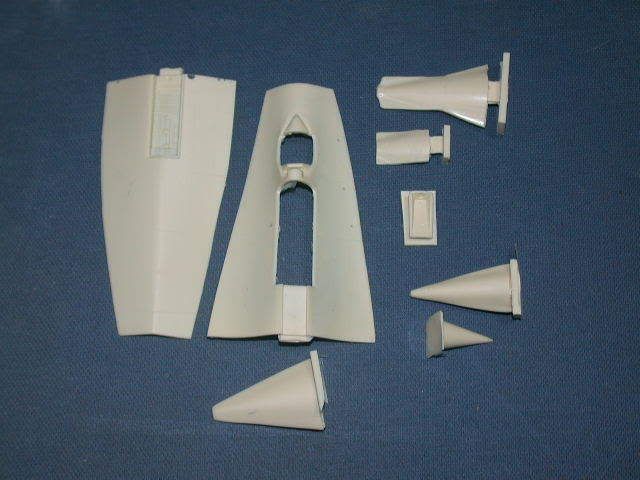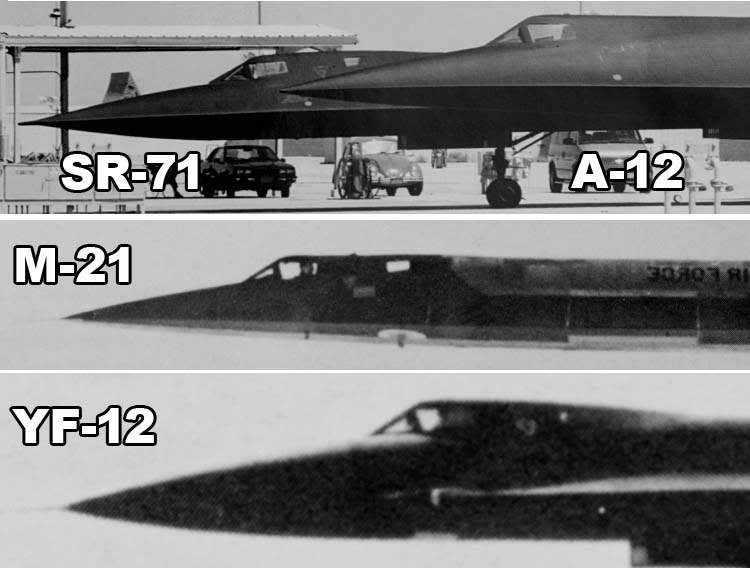One of those Monogram boxes in Yardbirds post says its 1/72. I always thought the Monogram bird was 1/48. I stand corrected.
Yardbird78 is definitly your man for SR-71 info, correct me if I’m wrong but were you not a crew chief with these things Darwin? I have the CE resin burner cans, TD cockpit and wheels for one of mine that hopefully will be built one day.
This was the first kit I tried when I got back into the hobby a few years ago. It was a challenge, especially with the putty. I think the hardest part was the little tail section. There was also a little flash on pieces. The decals were kinda turdy too. It does look good hanging from my sons ceiling though. Good luck with yours.[:)]
Chris
I also stand corrected on the 72nd Testors kit.
hello when you build the testors 1/48 sr-71 the best way to go about is to build the top half first and then the bottom half and then mate them together. it sounds like a lot of work-but the kit is a lot easier to manage this way. as for the a-12 cygnus i converted an sr-71 by using the tail section from the yf-12 kit. (does any one know if testors is going to re-issue the 1/48 yf-12 ?) i moved the air refueling receptable forward and scratchbuilt the narrower and shortend chine section. i also moved the ins forward of the front cockpit were it was located on the a-12. if any one is interested i could post photos of it.
I’d love to see photos of that!
how many parts does the 1/48 kiwi resin a-12 conversion kit compromise of? and is it easy to work with?
Nice work so far on your Blackbird wingform84, when I do another blackbird I’m thinking of doing the A-12. Good luck [tup]
This photo is the Kiwi 1/72 resin kit for converting the Testor’s/Italeri kit to an A-12. The two big pieces to the top left are the top and bottom forward fuselage with the nose tip just below them. The 5 pieces on the right, top to bottom are: upper fuselage tail cone, lower fuselage tail cone, air refueling receptacle, D-21 tail cone cover and D-21 nose cone cover. I am assuming that the 1/48th kit would have the same pieces, but I cannot confirm that.
The first few capture only flights with the D-21 were done with M-21 06940 and had the aerodynamic covers on both ends of the drone. This configuration had mostly NMF body and wings with black leading edges. Another point to remember if modeling the D-21 in the configuration as carried on the M-21 is to delete the pitot tubes on the wing leading edges. These were added during the conversion to B-model configuration for carriage on the B-52H. Another problem with both the Testor’s/Italeri and Monogram D-21s is that they show an exhaust as for a jet engine. The actual D-21 exhaust was a deep cone as in any large, missile, rocket engine.
Darwin, O.F. [alien]

OK, it could be just the angle, but that resin looks pretty warped. Stange. So is this an M-21 conversion, or an A-12 conversion with M-21 parts? The M-21 had a different forward fusealge than the A-12, and it had an extra seat for the LSO. The A-12 did not. Thus there’s a slight difference in the fuse section around the canopies.
Another note on the D-21, is that while much of the exhaust was conical, like you said…it di in fact have the jet exhaust in the center, for the Marquardt ramjet engine. Ironically enough, this is the only ramjet engine ever installed on a Blackbird system:

I have the 1/48th kit I’d love to get started but the decals went south years ago and I tossed them. Anyone know of decals available for the SR-71?
Kit decals by themselves occasionally show up on ebay and the two 1/48 Meteor sheets do also. The Meteor sheets are excellent, but usually pretty expensive.
Darwin, O.F. [alien]
The two M-21’s were modified on the assembly line using two A-12 airframes. The nose was the same. They converted the A-12’s Q-bay or camera bay immediately behind the pilot’s cockpit into a second cockpit for the Launch Control Officer. You can replicate that with the Testor’s model by using the piece for the normal SR-71A second cockpit instead of the raised B model piece. That will give you the side profile of an SR-71, which is somewhat higher than the A-12 and M-21, but is still pretty close.
Yes, the two Kiwi forward fuselage pieces are warped rather badly, but the resin is very thin and can be straightened fairly easily.
Darwin, O.F. [alien]
I copied this picture from a thread on the ARC forum. It shows the side profile of the A-12, M-21, YF-12A and SR-71A. The M-21 picture has the negative reversed, you are actually looking at the right side. Notice the backward lettering on US Air Force and the UHF antenna on the underside of the chine bay is on the wrong side.

Darwin, O.F. [alien]
Worth a 1000 words.
Cool pic. That top shot is interesting. I see what looks like a Buick Grand National and a Chevy Astro in the background, which would put it at the mid to late 80’s at the earliest. I didn’t think any A-12s were still flying that late. I know NASA had two YF-12A and an SR-71, but I don’t think they had any A-12s, did they?
They didn’t, but that pic could have been taken during a photo shoot, or during transit or soemthing. Not necessarily had to be in service at the time.
I knew you could do an M-21 by using some of the SR-71 parts for the second cockpit, since it isn’t raised like the SR-71B, Titanium Goose or YF-12. But I wasnt clear about using that resin set for just an A-12 or not.
The Blackshield A-12’s from Kadena and the ones still at Groom Lake were all flown to Palmdale in 1968 and put into long term storage. None ever flew again. I am not sure if that top picture is totally original or an A-12 image has been photoshopped onto an SR-71 picture. The only place that has an A-12 and SR-71 is the Palmdale outdoor museum. The picture might have been taken there, but the background doesn’t look quite right. This is a photo of the two Blackbirds together. It is a few years old because there is a U-2 behind and between them now. Click on the photo for a larger view.
http://static.panoramio.com/photos/original/8802177.jpg
Darwin, O.F. [alien]
A little trivia for Blackbird fans.
The SR-71 routinely flew at approximately 3,000 feet per second. That is 2045 statute miles per hour or 1776 knots, nautical miles per hour or slightly over Mach 3 at 80,000 feet altitude. She could hold this speed for about an hour and a half before running out of fuel. The cameras and other sensors were designed and adjusted for this speed and altitude. Any deviation above or below those numbers caused a degradation in sensor product results.
The limiting factor for speed was the air temperature at the inlet face of the compressor. IIRC, that was about 470 degrees F. Anything higher than that would cause serious damage to the engines. The outside air temperature had a big effect on the inlet temperature, so the maximum speed varied from one mission to the next. The practical limit was 3.5 Mach, plus or minus a slight bit. If you started a stop watch at the exact instant an SR-71 passed you, 2 seconds later she would be 1 mile away.
Blackbird speed and altitude were directly proportional. If you wanted to go faster, you had to go higher. If you wanted to go higher, you had to go faster. She could break Mach 1 at low altitude, but just barely. She burned more fuel per mile at sub sonic speed than at Mach 3. At cruise speed, approximately 20% of total thrust came directly from the engines, the remaining 80% came from the by-pass air ducted around the engines. Another Skunk Works, Kelly Johnson, Ben Rich brainstorm.
Darwin, O.F. [alien]
Talk about faster than the proverbial speeding bullet. That really is incredible speed.
To put this in perspective:
-
A 30-06 bullet from a WWII M1 Garand (or BAR) does about 2,900 feet per second right out of the barrel and slows quickly due to aerodynamic drag. By 100 yards it’s doing around 2,600 fps.
-
A modern 7.62x51 (.308) from an M-14 is doing somewhere around 2,700 fps right out of the barrel.
-
A modern 5.56 (.223) is doing around 2,900 fps from an M4 carbine (or 3,100 fps from a full size M16).
-
A 9mm, say from a Beretta M9 or Browning HP, would be doing around 1,200fps at the muzzle.
-
At sea level, Mach 1 is something like 1,100 fps (about 760mph). It’s a lower speed at higher altitudes. At 36,000 feet, it’s something like 960 fps (about 650mph).
So 3,000 fps is very, very fast. And the Blackbird could keep this speed for more than an hour! Only very recently could aircraft such as the F-22 even stay just supersonic for more than a few minutes.